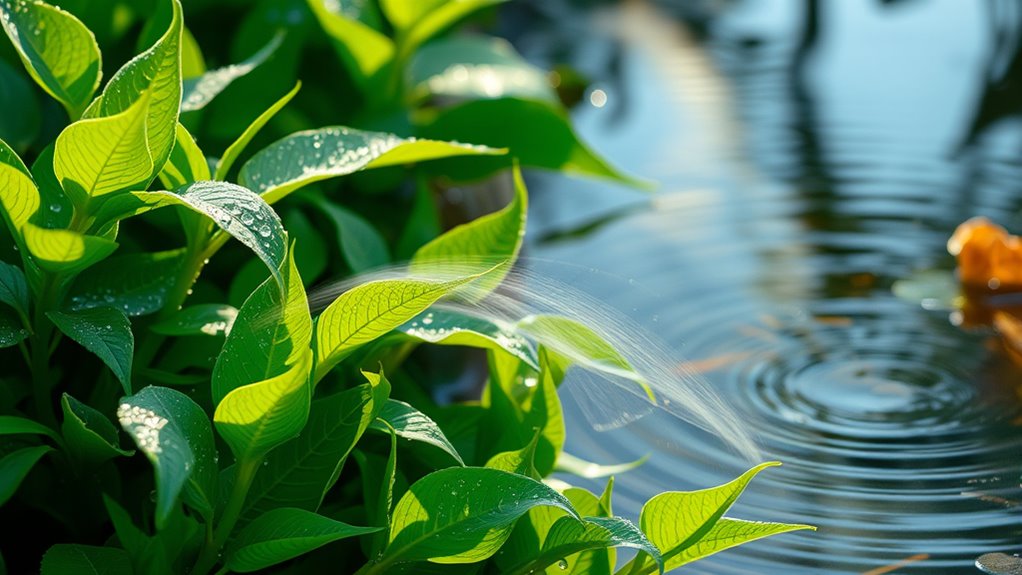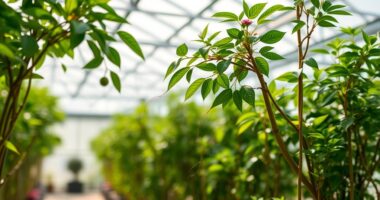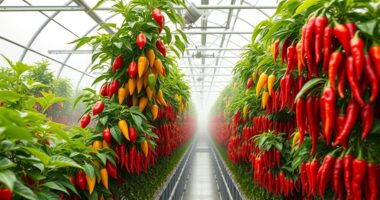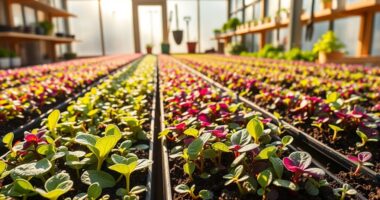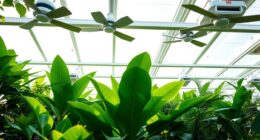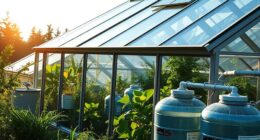Balancing humidity and airflow is key to healthy plant growth and a comfortable environment. When plants transpire, they release moisture, which can lead to excess humidity if not properly managed. Using good airflow helps distribute moisture evenly, preventing stagnant, humid pockets that encourage mold or pests. Proper ventilation, ventilation systems, and monitoring tools guarantee humidity stays in an ideal range. Keep exploring to discover how precise adjustments can optimize moisture control and support thriving growth.
Key Takeaways
- Proper airflow distributes humidity evenly, preventing stagnant pockets that can promote mold or fungal growth.
- Ventilation removes excess moisture generated by plant transpiration, maintaining optimal humidity levels.
- Using fans and monitoring devices ensures balanced moisture, avoiding both dryness and excessive humidity.
- Cross-ventilation and targeted airflow help regulate local humidity, supporting healthy plant growth.
- Understanding airflow patterns minimizes humidity-related issues, promoting a stable environment for plants and indoor air quality.

Understanding how humidity and airflow interact is essential for maintaining comfortable and healthy indoor environments. When you’re managing a space—whether it’s a home, greenhouse, or workspace—you need to consider how moisture levels and air movement influence plant health, occupant comfort, and overall air quality. One key process to keep in mind is plant transpiration, which is the way plants release moisture into the air through tiny pores called stomata. Transpiration naturally increases humidity levels around plants, especially in enclosed spaces, and if left unchecked, this moisture can lead to problems like mold or fungal growth. That’s why balancing humidity involves more than just adding or removing moisture; it requires understanding how airflow affects how humidity spreads and dissipates. Proper ventilation techniques are your best tools for controlling and optimizing airflow. Proper ventilation helps remove excess humidity generated by plant transpiration and other sources, preventing it from becoming stagnant. When you improve airflow, you promote a more even distribution of moisture and temperature, which helps plants transpire at a healthy rate without creating overly humid pockets. This can be achieved through simple methods like opening vents, using exhaust fans, or installing more advanced systems like climate control units that automate airflow regulation. The goal is to create a cycle where moist air rises and is replaced by drier, fresh air, maintaining a stable environment that supports both plant growth and occupant comfort. Additionally, understanding humidity control is crucial for preventing issues related to excess moisture, such as mold growth or pest infestations. You should also pay attention to how ventilation techniques influence airflow patterns. For example, cross-ventilation encourages air to move across a space, effectively replacing humid air with drier air from outside. Conversely, localized fans or air circulators can target specific areas to prevent humidity buildup around plants or in corners. Regularly monitoring humidity levels using hygrometers helps you make informed adjustments to your ventilation strategy. When you’re managing indoor environments, it’s crucial to monitor humidity levels regularly using hygrometers, so you can adjust ventilation accordingly. Too much airflow can dry out plants or cause stress, while too little allows humidity to rise excessively, fostering mold or pests. Striking the right balance involves understanding how these elements work together and making small adjustments based on real-time conditions. Incorporating air circulation devices can further optimize the environment by ensuring even distribution of moisture and temperature, preventing localized pockets of high humidity. Awareness of airflow patterns not only improves moisture control but also enhances overall air quality by reducing stagnant air zones. Being aware of how humidity distribution influences indoor conditions enables more precise control over climate variables and promotes healthier growth environments.
Frequently Asked Questions
How Does Humidity Affect Plant Nutrient Absorption?
Humidity level directly impacts your plant’s nutrient absorption. When humidity is too low, your plants struggle with humidity regulation, causing their stomata to close and limiting nutrient uptake. Conversely, high humidity can lead to excess moisture, fostering diseases that hinder healthy growth. Maintaining ideal humidity promotes efficient nutrient absorption by keeping stomata open, ensuring your plants get the nutrients they need. Proper airflow and moisture balance are key to thriving plants.
Can Airflow Prevent Pest Infestations?
Airflow can be your secret weapon against pest infestations; it’s like a mighty wind sweeping trouble away. By improving air circulation around your plants, you make it harder for pests to settle and reproduce. Good airflow not only strengthens plant health but also enhances pest control efforts, keeping bugs at bay. So, guarantee your space has proper ventilation—your plants will thank you with healthy, vigorous growth.
What Is the Ideal Humidity Range for Different Plant Species?
The ideal humidity range varies among plant species, impacting humidity control and plant transpiration. You should monitor your plants to maintain specific levels; for example, tropical plants thrive around 60-80%, while succulents prefer lower humidity at 30-40%. Proper humidity helps regulate transpiration, preventing stress and promoting healthy growth. Adjust your environment accordingly, ensuring each plant’s needs are met to avoid issues like mold or dehydration.
How Does Airflow Influence Temperature Regulation?
You understand that airflow plays a vital role in temperature regulation. It fosters air circulation, which helps disperse hot or cold pockets, maintaining a consistent environment. Proper airflow creates a temperature balance, prevents overheating, and reduces cold spots. By promoting steady air movement, you guarantee your plants thrive in stable conditions, avoiding stress caused by temperature fluctuations. Good airflow is fundamental for healthy growth, ensuring your plants stay comfortable and resilient.
Are There Tools to Monitor Both Humidity and Airflow Simultaneously?
You can find tools that monitor both humidity and airflow simultaneously, like advanced environmental sensors. These devices often feature hygrometer calibration for accurate humidity readings and connect to ventilation systems to optimize airflow. By using such tools, you get real-time data on moisture levels and air movement, helping you maintain ideal conditions. This guarantees plants stay healthy and reduces risks of mold or dryness.
Conclusion
Now that you understand how humidity and airflow work together, the real challenge begins. Will you find the perfect balance to promote healthy growth? One small adjustment could make all the difference, revealing lush, vibrant plants or inviting trouble. Keep experimenting, stay alert, and don’t underestimate the power of these unseen forces. The key to thriving plants is within your grasp—are you ready to discover what’s next? The secret’s just a breath away.
